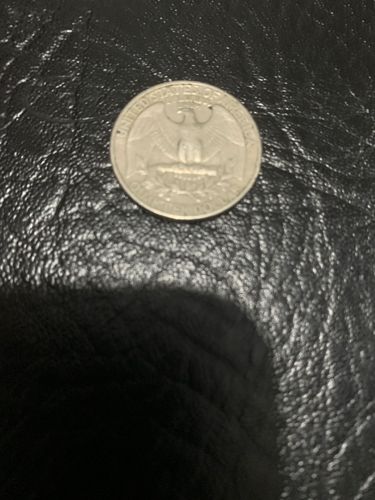Washington Quarter
Country of Origin: United States of America
Year of Issue: The exact year of issue is not visible in the provided image, as the date is on the obverse (front) side of the coin. Based on the composition (appearing to be clad) and common design, it is likely minted after 1964.
Denomination: Quarter Dollar (25 Cents)
Composition: Typically a copper-nickel clad, meaning a core of pure copper clad with an alloy of 75% copper and 25% nickel. Earlier versions (pre-1965) were 90% silver.

Brief Description
The coin clearly shows the reverse side of a United States quarter. The design features a bald eagle with outstretched wings, clutching an olive branch and arrows. Above the eagle, the words "UNITED STATES OF AMERICA" are visible, and below it, "E PLURIBUS UNUM" and the denomination indication "QUARTER DOLLAR". The eagle is a symbol of American strength and freedom.
Historical Significance
The Washington Quarter was first minted in 1932 to commemorate the 200th anniversary of George Washington's birth. It replaced the Standing Liberty Quarter. While initially intended for a one-year commemorative issue, it became a regular circulating coin due to its popularity. Post-1964 quarters, like the one depicted (which appears to be clad due to its modern appearance), transitioned from silver to copper-nickel clad compositions, marking a significant change in U.S. coinage due to rising silver prices. It remains one of the most widely recognized and circulated coins in the United States.
Estimated Value
For common dates and in circulated condition, like the one shown, a copper-nickel clad Washington Quarter typically holds its face value, which is 25 cents. Uncirculated examples or key dates/mint marks can fetch more, ranging from a few dollars to hundreds or thousands depending on rarity and condition. Without seeing the obverse (date and mint mark), a precise value is difficult, but it's likely a common modern issue worth face value.
Care Instructions
To properly care for this coin, avoid cleaning it, as cleaning can significantly decrease a coin's value. Handle the coin by its edges to prevent transferring oils from your skin, which can cause damage over time. Store it in a cool, dry place, preferably in archival-safe holders like non-PVC flips, slabs, or albums to protect it from environmental damage and physical scratches.
Created At: 2025-08-15T23:00:00.817268